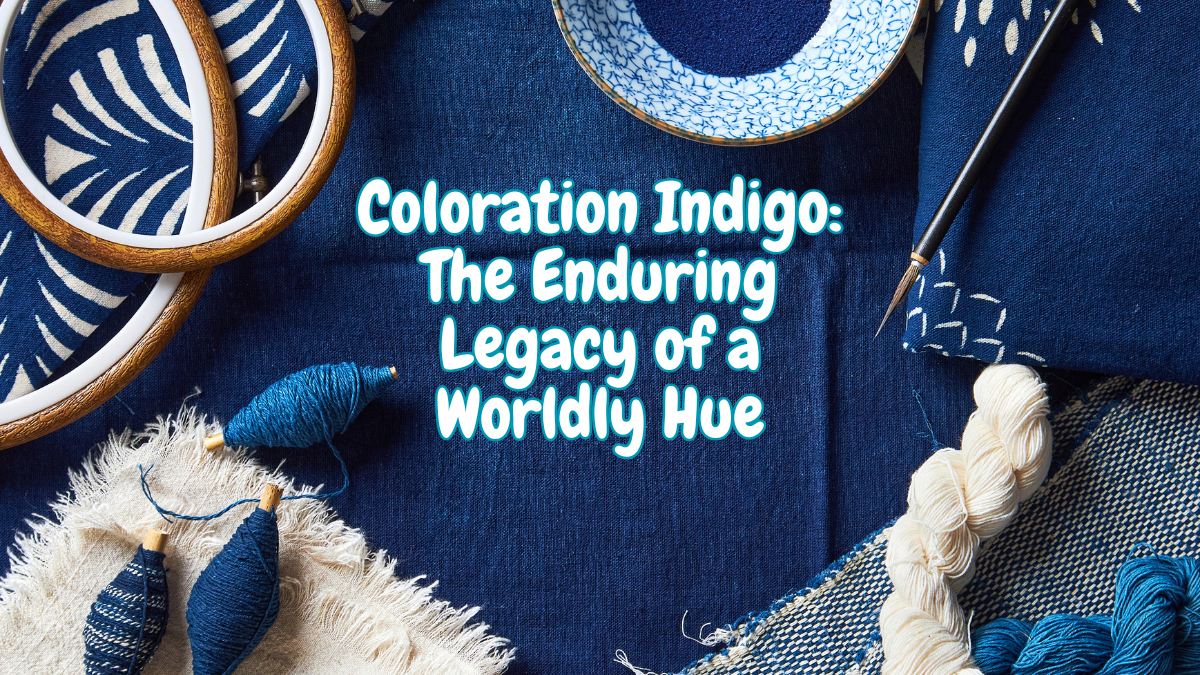Indigo is not just a color. It is a story woven into human civilization, a pigment that has traveled oceans, transformed economies, inspired spiritual practices, and shaped the very way we see the spectrum of light. When people search for “coloration indigo,” what they often want is clarity—what is this hue, where does it come from, why does it matter? In simple terms, indigo is a deep blue dye traditionally derived from plants, most famously Indigofera tinctoria, and it has been one of the most valued pigments across history, carrying both artistic and symbolic weight. But beyond that definition lies a vast world: from ancient trade routes to quantum chemistry, from denim jeans to digital color design, indigo is a global phenomenon that continues to matter today.
A Color Older Than Empires Coloration Indigo
Indigo’s origins stretch back thousands of years. Archaeologists have discovered traces of indigo-dyed fabric in Peru dating back 6,000 years—making it the earliest known use of the pigment anywhere in the world. The plant traveled across continents: in India, it became both a prized export and a symbol of colonial exploitation; in Africa, particularly in regions like Nigeria and Mali, it was central to textile traditions; in Japan, the art of aizome (indigo dyeing) grew into a craft of national identity.
The story of indigo is also a story of connection. No single empire or civilization could fully claim it. Instead, it passed hand to hand, ship to ship, culture to culture, coloring textiles that clothed kings and laborers alike.
As one textile historian wrote:
“Indigo was less a color than a passport—wherever it traveled, it carried stories of trade, identity, and power.”
The Chemistry of Coloration Indigo
Indigo’s mystique begins in biology. Natural indigo is produced from plants containing the precursor compound indican. When leaves are soaked and fermented, indican breaks down into indoxyl. Upon exposure to oxygen, indoxyl oxidizes and transforms into the rich, insoluble blue pigment known as indigo.
The insolubility of indigo is key: it does not dissolve in water, which makes it resistant to fading but also tricky to work with. Traditional dye vats required careful chemistry before chemistry was even a formal science. Artisans used fermentation, wood ash, and even urine as alkaline agents to reduce indigo into a soluble form that could cling to cloth. Once exposed to air, the fabric turned from greenish-yellow to the deep blue of legend.
In the 19th century, German chemist Adolf von Baeyer synthesized indigo in a laboratory, earning a Nobel Prize in 1905. This breakthrough revolutionized textile industries by reducing reliance on agricultural cultivation. Yet the synthetic version also brought environmental challenges, as industrial dyeing released harmful effluents into rivers.
Coloration Indigo in Cultural Symbolism
Indigo is not just pigment—it is meaning. Across cultures, indigo carried layers of symbolism:
- Spiritual: In Hinduism, the god Krishna is often depicted in indigo-blue skin, symbolizing cosmic depth.
- Protective: West African traditions saw indigo cloth as a shield, believed to ward off evil spirits.
- Political: During colonial India, forced indigo cultivation became a flashpoint of resistance, most famously in the Indigo Revolt of 1859.
- Philosophical: Isaac Newton even enshrined indigo in his sevenfold division of the visible spectrum, though modern scientists sometimes debate whether it truly deserves a place between blue and violet.
A Japanese dyer once reflected:
“Indigo is the color of patience—it begins invisible in the vat, and only time reveals its true face.”
A Table of Coloration Indigo Global Journey
| Region | Period | Cultural Role | Modern Legacy |
|---|---|---|---|
| Peru | 4000 BCE | Early dyeing of cotton textiles | Archaeological evidence of earliest indigo use |
| India | 2000 BCE–19th c. | Export and spiritual symbolism | Indigo Revolt, legacy in fabric industries |
| West Africa | 11th–19th c. | Ritual, protective garments | Enduring hand-dyed traditions like adire |
| Japan | 8th–19th c. | Samurai clothing, aizome artistry | Revived in sustainable fashion movements |
| Europe | 16th–20th c. | Luxury import, later synthetic production | Basis for modern denim industry |
The Indigo Revolt and the Politics of Color
In 19th-century Bengal, peasants were forced under colonial systems to grow indigo rather than food crops. This led to widespread exploitation and famine. The Indigo Revolt of 1859 was not just about farming; it was about dignity, sovereignty, and resistance against a system that demanded color at the expense of human life.
A contemporary Indian voice declared:
“The blue dye has stained not only our clothes, but the very blood of our people.”
Indigo’s story, then, is inseparable from politics. It shows how something as simple as color can be entangled in systems of labor, empire, and justice.
Indigo in the Modern World
Today, indigo is most familiar as the dye of denim. Every pair of jeans is a descendant of centuries of indigo traditions. Synthetic indigo dominates, but the slow fashion movement has sparked renewed interest in natural dyes. Designers are rediscovering plant-based indigo not just for sustainability, but for the depth and complexity of shades it produces—something machines cannot fully replicate.
Beyond textiles, indigo finds use in unexpected fields:
- Medical: Indigo derivatives have been studied for anti-inflammatory properties.
- Digital: In design systems, indigo is increasingly used as an interface color for its readability and psychological calm.
- Scientific: Indigo serves as a model compound in studies of organic semiconductors.
Why Indigo Still Matters
Indigo persists because it sits at the intersection of art, science, and society. It is ancient yet modern, spiritual yet practical, natural yet industrial. Unlike many colors that fade in relevance, indigo has managed to remain both ubiquitous and mysterious.
Consider these points:
- Indigo connects ancient textiles to modern fashion.
- It symbolizes both oppression and resistance.
- Its chemistry influenced industrial revolutions, while its craft supports sustainable futures.
- It exists both as a color we wear and as an idea we project—mystical, timeless, profound.
Quotes That Capture Indigo
- “Indigo is less a color than a passport—wherever it traveled, it carried stories of trade, identity, and power.”
- “Indigo is the color of patience—it begins invisible in the vat, and only time reveals its true face.”
- “The blue dye has stained not only our clothes, but the very blood of our people.”
- “Every indigo cloth is a page in the diary of human civilization, dyed in sweat, soil, and sky.”
Bullet Point Summary for Readers
- Indigo is one of the oldest known dyes, with origins tracing back 6,000 years.
- It is derived from plants, though synthetic versions dominate today.
- Cultures worldwide assigned deep spiritual, political, and protective symbolism to indigo.
- The Indigo Revolt of 1859 marked a historic resistance against colonial exploitation in India.
- Modern uses extend beyond textiles to medicine, digital design, and sustainable fashion.
Frequently Asked Questions (FAQs)
1. What is indigo made from?
Traditionally, indigo comes from plants like Indigofera tinctoria. The leaves undergo fermentation and oxidation to yield the pigment.
2. Is indigo different from blue?
Yes. Indigo is a distinct hue between blue and violet. While sometimes debated scientifically, culturally it has always been seen as unique.
3. Why was indigo historically valuable?
It was rare, labor-intensive to produce, and produced a dye that resisted fading. This made it a global luxury commodity.
4. Is synthetic indigo harmful?
Synthetic indigo is chemically identical to natural indigo but mass production can lead to environmental pollution if wastewater is untreated.
5. Why does indigo still matter today?
It remains central to denim fashion, is being revived in sustainable design, and continues to carry cultural and symbolic significance worldwide.











